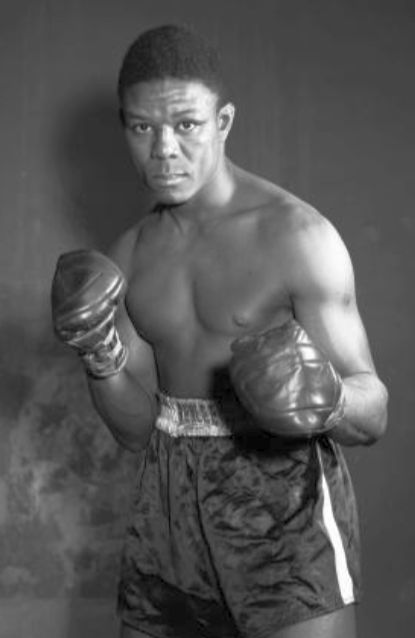Virgil Akins: His Long Journey to the World Welterweight Title
by Dan Cuoco
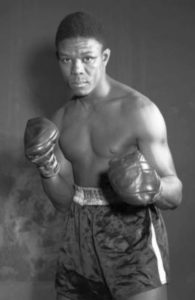 Virgil Akins was born in St. Louis, Missouri, on March 10, 1928. The Akins family lived in a three-room flat at Second and Mullanphy Streets, a short distance from the Mississippi River. His father died when he was nine years old, and the family, which included three sisters and a brother, were poverty-stricken. Young Virgil chopped railroad ties, which he sold as kindling wood, and took other odd jobs to help his family. After he married and had two children, ten people were living in those three rooms.
Virgil Akins was born in St. Louis, Missouri, on March 10, 1928. The Akins family lived in a three-room flat at Second and Mullanphy Streets, a short distance from the Mississippi River. His father died when he was nine years old, and the family, which included three sisters and a brother, were poverty-stricken. Young Virgil chopped railroad ties, which he sold as kindling wood, and took other odd jobs to help his family. After he married and had two children, ten people were living in those three rooms.
Before turning pro, he held the St. Louis District lightweight crown in 1946 and 1947 and, later in the year, was a member of the Western Golden Gloves team. His amateur record was a respectable 72-7. Two prominent opponents he defeated as an amateur were Del Flanagan and Jesse Turner.
Pre-Prime (November 1947- December 1954)
Virgil turned pro in Kansas City on November 4, 1947, under the management of Johnny Tocco. He fought as Jimmy Foxx for his first two pro fights and changed back to his birth name on his return to St. Louis on March 10, 1948, under the management of Arthur Liebert and trainer Turuche (Chico) Larretz. Lou Wallace took over his management from 1948-1952, and George Gainford managed him in 1953.
His pro career started well, winning ten of his first eleven fights, three by kayo. His only loss occurred in his fourth pro fight on April 5, 1948. Virgil was initially announced the winner on a foul in a bristling battle with Charley Baxter of Cincinnati, but ten minutes later, the boxing commission reversed the verdict. Virgil went down in the third round of the scheduled six-round preliminary at Kiel Auditorium in St. Louis from a left hook that appeared low. When he was unable to continue and seemed semi-paralyzed for several moments, referee Paul Spic recommended the fight go to Virgil on a below-the-belt foul. However, he was overruled by Dr. Freedman, who said evidence showed he was not fouled. The commission then awarded Baxter a technical knockout.
In a rematch, sixteen days later, Virgil won a unanimous decision over Baxter in an action-packed six-rounder at Kiel Auditorium in St. Louis. But, unfortunately, his record became spotty after his ten-and-one start, looking good one night and bad another night. For every Bud Smith, Joe Brown, Freddie Dawson, Luther Rawlings, and Tommy Campbell he beat, there were losses to less talented fighters, such as Joe Fisher, Nelson Levering, and Gene Parker.
In 1951 he twice defeated Wallace “Bud” Smith, Tommy Campbell, Freddie Dawson, and Luther Rawlings. After losing two decisions to Joe Brown, Virgil won a decision over Brown in their third meeting. Virgil’s ten-round split decision win over long-standing number one ranked lightweight contender Freddie Dawson on September 26, 1951, moved him into Ring magazine’s December 1951 world lightweight ratings for the first time at number four. Dawson’s subsequent departure to the welterweight division elevated Virgil to number three in Ring magazine’s January 1952 issue. Further victories over Luther Rawlings and Joe Brown elevated Virgil to number two in Ring magazine’s ratings.
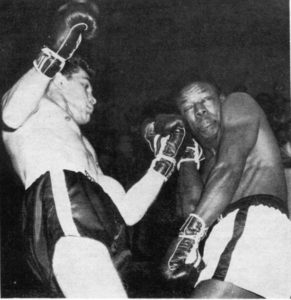
In 1952, Virgil retained his number two Ring rating with four consecutive kayos over Baby Leroy (TKO 4), Joe Gilmer (TKO 9), Henry Davis (TKO 9), and Jay Watkins (KO 2) until back-to-back losses to welterweights Johnny Saxton and Joe Miceli broke his streak. Saxton rallied from a first-round knockdown to win a unanimous decision. Against Miceli, Virgil fought a defensive, retreating bout as he appeared weary of Miceli’s left hook. The referee warned Virgil to pick up the pace after four rounds, but he was hurt in the fifth and returned to his cautionary tactics. These two losses saw him tumble in the Ring ratings to number eight. After the Miceli fight, Virgil stayed out of the ring for seven months and was dropped from the Ring ratings.
In 1953 his career dropped to an all-time low as he saw his losing streak reach four, losing a majority ten-round decision to Johnny Gonsalves and a devastating tenth-round stoppage loss to Hawaiian welterweight Phil Kim.
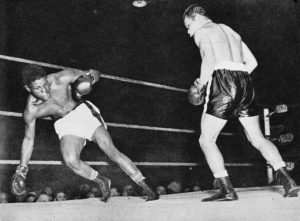
The Kim fight occurred on August 29, 1953, in a nationally televised main event at Rainbo Arena, Chicago, Illinois. Virgil, who was leading on two of the three official score cards through the first nine rounds, was knocked down twice in the final round, both from left hooks to the head. He went down for a four-count the first time and then for nine, after which referee Joey White stopped the bout at 2:11 when he was unable to raise his arms. Both fighters weighed 141 ½ pounds. Dr. Irving Slott, the athletic commission physician at the ringside, administered oxygen to him and later ordered his manager George Gainford to take him to Columbus Memorial hospital as a cautionary measure. Dr. Slott said there did not appear to be anything wrong with him except for exhaustion. After Virgil’s loss to Kim, he returned to St. Louis but was idle for ten months because he found it tough to get a fight. During that time, he left the management of George Gainford and hooked up with Bobby Gleason.
On June 2, 1954, Virgil returned to the ring after a 10-month layoff to face journeyman Joey Greenwood of Akron, Ohio, in a ten-round semi-final at St Louis Arena. Virgil, rusty after the long layoff, still had enough to pound out an eight-round TKO over Greenwood. Virgil scored a knockdown in the fifth and two more in the seventh. Greenwood wasn’t able to come out for the eighth. He was idle for another four months when he traveled to New Orleans on October 16, 1954, and lost a ten-round split decision to local fighter Andrew Brown at the Coliseum. Brown piled up a commanding lead in the early rounds, only to have Virgil come on strong in the last three stanzas. Ten days later, Virgil won a unanimous eight-round decision over Henry Hank of Detroit in the featured bout at Motor City Arena. Virgil floored Hank twice – once in the first round and again in the third. Hank made his best showing in the second round when he started a counterattack. After that, Virgil was never in difficulty and appeared to be using the final rounds of the fight as a workout. After only engaging in five fights in the past two years and no prospects in sight, Virgil, now a free agent, was ready to call it quits.
Prime (March 1955 – June 1958)
In early 1955 Virgil returned to St. Louis discouraged and ready to give up boxing. Training meant nothing to him, as he was merely going through the motions. Then, one day in the gym Eddie Yawitz, a St. Louis druggist who managed fighters as a sideline, noticed the change in Virgil’s demeanor and struck up a conversation with him. He told him that anyone who could punch like him should be a champion. Akins looked at Yawitz at first through cynical eyes. At age 27, he felt that the series of managers since he turned pro had fleeced him. But as the druggist kept repeating his words of encouragement, Virgil’s morale began to lift. Finally, Virgil blurted out, “I’d like to fight for you.” The druggist quickly backed up his enthusiasm with cash. Yawitz joined forces with Bernard Glickman, a Chicago manufacturer with good boxing connections who came on as co-manager. Before signing with Yawitz and Glickman, Akins’ record stood at 27-13-0 (KO 11/KO by 2), with five losses occurring in his last seven fights.
Conscious of Virgil’s natural punching power, they let him do want he had always wanted to, and it came naturally. He became a puncher rather than a boxer. Virgil was willing to give up some of his defense to probe opponent weaknesses and the willingness to take punches to land his own power punches. The results were immediate. During his three-year run to the world title he compiled a record of 23-4-2, 18 by knockout.
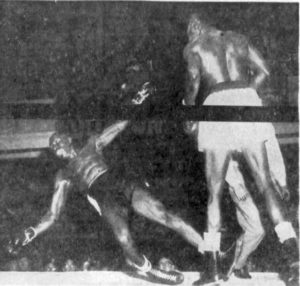
Virgil’s breakout year turned out to be 1955. Returning to the ring after a five-month layoff, Virgil stopped Johnny Brown in the tenth-round at Miami Stadium in Miami; stopped Tommy Maddox in four-rounds at Marigold Gardens in Chicago; drew with Johnny Brown in a rematch at the Arena in St. Louis; scored an upset eight-round knockout over middleweight contender Ronnie Delaney at St. Nicholas Arena in New York; stopped former conqueror Joe Miceli in the first-round at St. Nicholas Arena in New York; stopped Bill Sudduth in eight rounds at Marigold Gardens, in Chicago; won a ten-round split decision over welterweight contender Issac Logart at St. Nicholas Arena in New York; won a unanimous decision over Harold Jones at Victory Field in Indianapolis, Indiana; and ended the year losing a ten-round decision to Issac Logart in their rematch at Madison Square Garden in New York. Virgil’s upset of middleweight contender Ronnie Delaney of Akron, Ohio, moved him into Ring magazine’s world welterweight ratings at number six. Subsequent victories over Miceli, Sudduth, Logart, and Jones elevated him in the Ring ratings to three, but his loss to Logart dropped him to number six by year’s end.
Virgil’s stunning kayo of Delaney was one of the year’s biggest surprises. The 25-year-old Delaney entered the ring with a record of 59-1-3 (KO 27), and his only defeat had occurred seven years previously, in 1948. The Akron southpaw had been touted as one of the most dreaded fighters in the ring and was a top-heavy favorite over Virgil. At no time during the bout did the odds seem justified. Going into the eighth round, the fight was dead even. Neither fighter had been in trouble at any time during the bout, and the sudden ending was totally unexpected. As Delaney backed away from a clinch, Virgil lashed out with a left hook. It caught Ronnie flush on the chin, and he staggered. Virgil promptly stepped in with a right cross, and Delaney went down flat on his back. At eight, he tried to rise but pitched over on his face as referee Barney Felix counted him out.
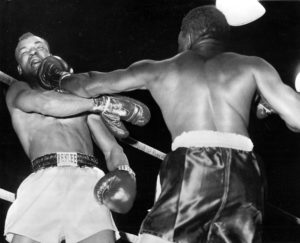
In 1956, Virgil entered the ring eight times, winning six by kayo, one by decision, and losing one by decision. He stopped Rudolph Bent in five rounds at Valley Arena in Holyoke, Massachusetts; kayoed Clarence Cook in four rounds at the Sportatorim in Dallas, Texas; stopped Mel Barker in eight rounds at the Alnard Temple, in East St. Louis, Illinois; stopped Andy Watkins in two rounds at Alnard Temple, in East St. Louis, Illinois; won a unanimous decision over Hector Constance at the Arena, in St. Louis, Missouri; stopped Don Jose at Kallio’s Arena in Monroe, Louisiana; lost a unanimous decision to Charley Sawyer, at Legion Stadium in Hollywood, California; and kayoed Pat Lowry at Biscayne Arena, Miami Florida. He ended his successful 1956 campaign as Ring magazine’s fifth-ranked world welterweight contender.
Virgil started 1957 with five consecutive victories before dropping two out of his last four fights. He won a ten-round unanimous decision over Sammy Walker at Memorial Auditorium in Buffalo, New York; stopped Al Andrews in six rounds at Kiel Auditorium in St. Louis, Missouri; won a unanimous ten-round decision over Franz Szuzina at Kiel Auditorium in St. Louis, Missouri; stopped Jimmy Beecham in three rounds at Capital Arena in Washington DC; won a ten-round unanimous decision over Walter Byars at the Arena in Norfolk, Virginia; lost a ten-round unanimous decision to Franz Szuzina in a rematch at Kiel Auditorium in St. Louis, Missouri; stopped Garnet (Sugar) Hart in eight rounds at Public Hall in Cleveland, Ohio, lost a ten-round decision to Gil Turner at Convention Hall in Atlantic City, New Jersey; and kayoed Tony DeMarco in Boston, Massachusetts, in fourteen rounds billed in Massachusetts as a welterweight title match. His impressive knockout of top-ranking Tony DeMarco elevated him to the top of the division by Ring magazine and the NBA and in prime position along with Issac Logart, Gil Turner, Vince Martinez, Gaspar Ortega, and George Barnes to compete in the welterweight elimination tournament to crown a successor to Carmen Basilio, who vacated the title when he beat Sugar Ray Robinson for the middleweight title.
Akins Rises to the Occasion
Dan Daniel of Ring magazine wrote, “Akins has proved himself eminently able to rise to an occasion. He came into the competition as an underdog. Gil Turner had beaten him. This after Virgil’s eight-round knockout of Sugar Hart and on top of a defeat by Franz Szuzina. Once entered in the welter eliminations, Akins stopped fooling around. He made Tony DeMarco retire from the ring with two knockouts in Boston.”
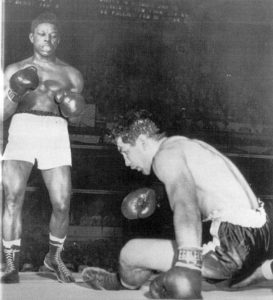
The first Akins-DeMarco fight took place on October 29, 1957, and was among the most savage and exciting fights ever held in the Boston Garden. In a war of attrition, Virgil floored DeMarco three times in the 14th round for a knockout. Virgil spent the early rounds sending out left jabs and hooks to score against the hard-hitting DeMarco and picking off Tony’s blows with a slip of the shoulder and dart of the glove. Virgil was dropped in the 12th round before finishing DeMarco with a smashing two-handed flurry at 1:17 of the 14th – the 6th time in the bout DeMarco had been on the canvas. After the fight, the NBA and the NSAC said that they did not regard the meeting as a championship bout but only as an elimination in the tournament, which would ultimately name a successor to Carmen Basilio.
Akins and DeMarco met in a rematch on January 21, 1958, again at the Boston Garden, once more for the Massachusetts version of the welterweight championship. Virgil scored a twelfth-round technical knockout in another brutal match. He finished the bout with a jarring right uppercut forcing referee Eddie Bradley to stop the fight. DeMarco had been down once in the eighth round and twice in the eleventh but didn’t know how to quit until Bradley made the decision for him before an overflow crowd of some 15,000 screaming fans.
With top-rated DeMarco out of the way, the final six vying for the vacant title were Virgil Akins, Isaac Logart, Vince Martinez, Gil Turner, Gaspar Ortega, and George Barnes. Isaac Logart advanced when he defeated Gasper Ortega in twelve rounds on December 6, 1957. Six days earlier, Vince Martinez also advanced with a twelve-round majority decision over Gil Turner. With three fighters left in the tournament due to George Barnes’ withdrawal, Julius Helfand, chairman of the state commission, and the championship committee arranged a draw to determine the next pairing. Nat Fleischer, publisher of The Ring, drew out the names, first Akins and then Logart, so Martinez automatically got the bye.
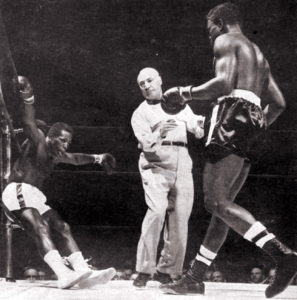
On March 21, 1958, Virgil stopped the shifty Issac Logart in the sixth round of their welterweight tournament semi-final at Madison Square Garden. The end came with surprising suddenness. Logart had dazzled Virgil with his flashing hand speed and clever maneuvering. In the first, second, fourth, and fifth rounds, Logart landed significantly more punches than Virgil. Until the sixth, Virgil’s best round was the third, when he came on strong in the last two minutes. He scored with some right hands for the first five rounds, but none landed flush. Virgil finally caught up with Logart early in the sixth round and staggered him with two right hands to the jaw, followed by a right to the body and a push that dropped him. Logart arose groggily at three and was given the mandatory eight count. Virgil belted away at Logart with both hands. A right sent Logart sagging into a sitting position on the ropes. Although he didn’t hit the floor, referee Harry Kessler ruled it a knockdown and gave him another eight count. Virgil roared in for the knockout. He smashed Ike to the ropes with both hands. With a cut over his right eye and a bloody mouth, he was headed to the canvas when Kessler stopped the fight. This was their rubber match. They had met twice before in 1955. Virgil won the first by split decision, and Logan evened the score, winning a unanimous decision in the return bout.
Virgil hardly got a chance to enjoy his victory. Right after the bout, the New York District attorney subpoenaed both fighters and their managers as part of a continuing investigation into the influence of underworld figures on boxing in New York. Despite the odds favoring Logart, a lot of “smart money” had been placed on Virgil just before fight time. In the end, a Grand Jury cleared all parties of any wrongdoing.
On June 6, 1958, Virgil met Vince Martinez in Virgil’s hometown of St Louis, MO, for the vacant world welterweight championship. Virgil, moving fast out of his corner, didn’t waste any time. Just thirty seconds into the opening bell, the entire pattern of the fight was set. Virgil moved in and landed a left to the side of Vince’s head, a solid left hook to the body, followed by a right crossing over Martinez’s left. Down went Vince. Caught cold, Vince never was in the fight after the first knockdown. Before the round had ended, he had been down four more times.
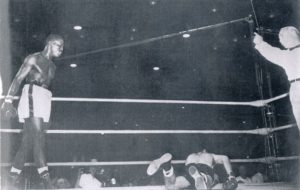
The second round saw Martinez remain off the canvas for only three minutes of the fight. Although he was completely on the defensive with a cut under his right eye and nose bleeding profusely, he appeared to be gaining strength. He made good use of his left jabs with one flurry of combinations more like the Martinez the fans had expected to see
But Vince’s short rally didn’t last long. Twice more in the third and twice more in the fourth session, Martinez was slugged to the canvas by Virgil’s booming right before the referee raised his hand in triumph at 52 seconds of that fateful fourth with Martinez on the deck, drained of all ability to fight. Kessler explained later that he could have counted to thirty over Martinez without him getting up.
The casual onlooker must have found it difficult to understand how a cautious, clever, experienced boxer like Vince Martinez could have been demolished in such a hurry by his hard-hitting but slower-moving opponent. Virgil explained after the fight that he had exploited a weakness he spotted in Martinez’s style in watching four of Martinez’s televised fights. Martinez telegraphed his vaunted left hook. He made a peculiar movement of his head and dropped his left hand too low before striking with it.
Philadelphia Boxing Historian Chuck Hasson shared his observations with me. “Of course, anybody can be caught cold – but I remember after Akins kayoed Isaac Logart in the welterweight tourney semi-final, he was asked his thoughts on the upcoming Martinez match, and Virgil said he would kayo Vince because Vince had a habit of double jabbing, dropping his hands and leaning back, real pretty like, and when Vince does that he has to throw two straight right hands the first probably missing but the second will be on the money. Obviously, Vince wasn’t listening because 30 seconds after the fight started, the scenario played out just as the prognosticator Akins had called it. I think Akins was one of the most dangerous welters in history from 1955 to 1958 (check his record).”
After winning the title, Virgil took his wife to Mexico. When he returned, he discussed prospective challengers with Eddie Yawitz. They both hoped that recently dethroned middleweight champion Carmen Basilio would reenter the welterweight division because he would give them their biggest payday. Moreover, they didn’t fear Carmen because they were sure Virgil hit harder than anyone in the division. This confidence made Virgil announce that if Basilio wasn’t available, he didn’t care who he fought.
Father Time Catches Up to Athletes
Father time catches up to athletes, sometimes gradually and sometimes overnight. But it is most common in professional fighters because of the punishment they endure throughout their careers. At age 30 and having engaged in over 70 fights, Virgil’s body’s physicality eventually caught up with him, and naturally so, starting with his fight against Charley (Tombstone) Smith. When he tried to counter, he found his punches were falling short and missing his target repeatedly. Moreover, his face and eyes were also paying a heavy price.
Post-Prime (August 1958 – March 1962)
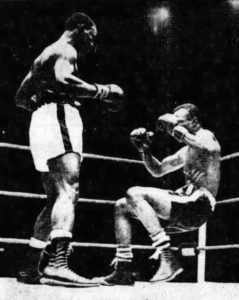
On August 20, 1958, at Chicago Stadium, Virgil looked nothing like a champion against Charley (Tombstone) Smith and was a beaten fighter for nine rounds. Smith outboxed him and badly cut his left eye and bruised his right eye. Virgil was unable to land solidly on his taller opponent and was equally unable to keep Smith’s jolting left jabs from connecting. Going into the final round, he was behind on the scorecards of all three officials. Virgil came out for the tenth with a rush and swarmed all over Smith. Then, out of nowhere, he landed a crushing left hand on Smith’s face, and down he went. Smith staggered to his feet at the count of eight in obvious distress. Virgil quickly maneuvered him into a neutral corner and had him all but out on his feet when referee Frank Sikora stopped the fight at 1:18 of the final round.
On September 18, 1958, Del Flanagan won a decisive ten-round decision over Virgil at the Saint Paul Auditorium in Minnesota, utilizing his speed and neat combination punching. Virgil, apparently protecting bruises above his eyes inflicted in the Smith fight 29 days earlier, fought in spurts winning only the sixth and ninth rounds. Virgil blasted Flanagan from pillar to post in the ninth round, winning the round decisively. But Flanagan won the tenth round just as decisively, as he finished much stronger. When the fight was over, one again asked why did Virgil take the fight. It must have been for the money because even if he won, he didn’t figure to gain anything from it. To make matters worse, his one-sided beating eventually cost him his long-sought lucrative fight with Carmen Basilio.
On October 22, 1958, Don Jordan won a twelve-round split decision over top-rated Gaspar Ortega in a twelve-round elimination bout and earned a world title fight with Virgil. After viewing the fight on television, Virgil boasted confidently that he would knock out Jordan within three rounds. “There isn’t a welterweight around who can stay with me,” he said. “I’m the champion because I’m the best. I’m no second Kid Gavilan or Ray Robinson. I’m the first Virgil Akins.”
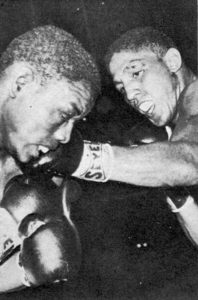
On December 5, 1958, Virgil lost his world welterweight title in a stunning upset to 3-1 underdog Don Jordan at the Olympic Auditorium in Los Angeles. The fifteen-round decision was unanimous by a substantial margin. Jordan maintained a torrid pace throughout the bout, whipping in a string of left jabs, left hooks, and occasional rights to the head when in close. Seldom did he allow Virgil punching room, but when he did, he often got the better of the exchanges. Jordan hurt Virgil in the tenth and eleventh rounds. By the end of the eleventh, Virgil’s face was smeared with blood. His left eye was cut and beginning to swell. Virgil picked up the pace in the latter stages and threw punches desperately in an effort to score a knockout but was never able to catch the smooth boxing and active Jordan. Referee Lee Grossman scored 145-138; Judge Mushy Callahan scored 145-132; and Judge Tommy Hart 146-136.
Virgil was so sure he would knockout Jordan within a few rounds that he had booked a 9:15 PM airplane reservation to Los Angeles international airport. He allowed himself two hours and fifteen minutes from the start of the fight to get it over with and make the fifteen-mile trip. After fifteen rounds, he had to take a later plane. Being overconfident and not mentally or physically prepared can lead to what Mike Margolies, a sports psychology consultant, describes as an athlete ‘sleepwalking through a game.’ Oh, how prophetic!
His title loss and a subsequent rematch with Jordan destroyed his confidence
His title loss and a subsequent rematch with Jordan destroyed his confidence resulting in his career spiraling downhill until his retirement in March 1962. During that time span, he fought 23 times, compiling a record of 10-12-1 (KO 5/KO by 0).
In 1959 he lost a unanimous decision to Don Jordan in a world title rematch; lost a unanimous decision to Luis Rodriguez; won a majority decision over Stan Harrington; lost a majority decision to Kenny Lane; and lost a split decision to Denny Moyer.
In 1960 he lost a unanimous decision to Don Fullmer; lost on points to Wally Swift; won on points over Fernando Barreto; won a unanimous decision over Charley Scott; lost a unanimous decision in a rematch with Luis Rodriguez; knocked out Carl Hubbard in five; and lost a split decision to Candy McFarland.
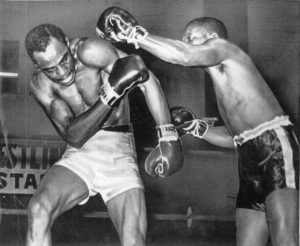
In 1961, he stopped TJ Jones in nine; won a majority decision over Gerald Gray, won a unanimous decision over Billy Collins, stopped Cecil Shorts in eight; lost a majority decision to Henry White; lost a unanimous decision in a rematch with Kenny Lane; stopped Jose Antonio Burgos in one; fought a draw with Stefan Redl; stopped Vince Bonomo in four; and lost a unanimous decision to Ralph Dupas.
On March 20, 1962, Virgil engaged in his last professional fight losing a unanimous decision to Rip Randall in Houston, Texas. He was forced to retire when it was discovered he was suffering from a detached retina in his left eye. His final ring record: 62-31-2 (KO 35/KO by 2).
But like thousands of fighters before and after him, life after boxing doesn’t always end with a happy story. His restaurant (The Honey Bear) was forced to close, and he went from one job to another. He was a construction worker, a cook at a local hotel, a shipping clerk at a candy company, and a high school custodian. An accident at the candy company reinjured his retina and cost him the vision in his left eye. His personal life also suffered as he and his wife of 23 years separated. In addition, his earnings from boxing, estimated at more than $150,000, were lost because of income tax problems, bad investments, and bad advice from men he used to trust.
In 2005, Virgil was honored with a place on the St. Louis Gateway Classic Walk of Fame, which pays special tribute to African-American men and women from St. Louis who have made significant contributions on the local and national level.
Virgil Akins died in St. Louis on January 22, 2011 at the age of 82.
Primary Sources: Ring Magazine, Boxing Illustrated Magazine, Boxing Yearbook Magazine, St. Louis Globe-Diplomat, St. Louis Star, St. Louis Dispatch, Milwaukee Journal, Newport Daily Express, LA Times, New York Daily News, New York Times, Boston Globe, Cincinnati Enquirer, New Orleans Picayune, and several online premium databases.
I sincerely thank Colleen Aycock and Chuck Hasson for their insightful comments.
